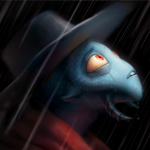04-29-2012, 06:01 AM
I'll try to make a quick explanation here.
Basically, the images aren't solid - they're artwork which has pixels around them which are semi-transparent. So ranging from 1% to 100%, making the curves and edges look smooth. Unlike your usual sprites, these will blend into the background more because it will have colours of the background included.
This is used in the tool shelf so that when the tool is over the background of the shelf, it won't look pixely and nasty, and it also won't have random colours that aren't relevant to the colour of the background.
Mario & Luigi for the DS and GBA replicate this, using slightly lighter black colours on the border of the sprites, to make it blend a bit more - it's a neutral colour, and makes the sprites look smoother. It's like anti-aliasing, basically.
The glow is just an easy way of showing it in a larger lump of colour, but it applies to the border of some smaller sprites too, though rarely. It's often hard to see
![[Image: may.png]](http://spriters-resource.com/other_systems/crossedge/may.png)
As an example though, copy this sheet and paste it into paint, and it'll have a black background - if you fill that black into a different colour, the sprites will have a black border - but looking at the sheet here, the sprites don't have black borders. This is because the semi-transparency surrounding these sprites blended into the black from pasting it into paint.
The way around this is to save the sheet, and open it using photoshop, gimp, or something of that nature - it'll keep the transparency, and let you have the sprites blend better over other colour backgrounds.
Make sense?
Basically, the images aren't solid - they're artwork which has pixels around them which are semi-transparent. So ranging from 1% to 100%, making the curves and edges look smooth. Unlike your usual sprites, these will blend into the background more because it will have colours of the background included.
This is used in the tool shelf so that when the tool is over the background of the shelf, it won't look pixely and nasty, and it also won't have random colours that aren't relevant to the colour of the background.
Mario & Luigi for the DS and GBA replicate this, using slightly lighter black colours on the border of the sprites, to make it blend a bit more - it's a neutral colour, and makes the sprites look smoother. It's like anti-aliasing, basically.
The glow is just an easy way of showing it in a larger lump of colour, but it applies to the border of some smaller sprites too, though rarely. It's often hard to see
As an example though, copy this sheet and paste it into paint, and it'll have a black background - if you fill that black into a different colour, the sprites will have a black border - but looking at the sheet here, the sprites don't have black borders. This is because the semi-transparency surrounding these sprites blended into the black from pasting it into paint.
The way around this is to save the sheet, and open it using photoshop, gimp, or something of that nature - it'll keep the transparency, and let you have the sprites blend better over other colour backgrounds.
Make sense?







![[+] [+]](images/collapse_collapsed.png) Spoiler
Spoiler![[Image: Hue_alpha.png]](http://upload.wikimedia.org/wikipedia/commons/a/a7/Hue_alpha.png)



 I hadn't really had much experience with sprites that had semi-transparency, but I understand it more now.
I hadn't really had much experience with sprites that had semi-transparency, but I understand it more now.
![[Image: CvlJ7PI.png]](https://i.imgur.com/CvlJ7PI.png)

![[Image: sweet-capn-cakes-deltarune.gif]](https://cdn.discordapp.com/attachments/365278865259626499/937745593042874368/sweet-capn-cakes-deltarune.gif)
 , but if you could leave me the backgrounds, support characters, Kururu and Tamama (hopefully that isn't claiming too much :/) then that would be awesome. Ploaj is also working on some stuff, so you may need to PM him.
, but if you could leave me the backgrounds, support characters, Kururu and Tamama (hopefully that isn't claiming too much :/) then that would be awesome. Ploaj is also working on some stuff, so you may need to PM him.

![[Image: scaled.php?server=441&filename=ipposig.png&res=medium]](http://desmond.imageshack.us/Himg441/scaled.php?server=441&filename=ipposig.png&res=medium)
 ).
).